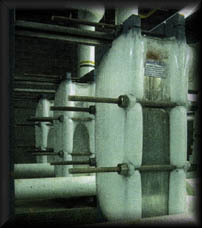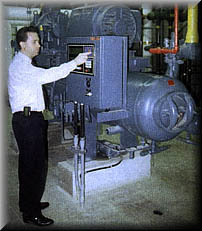

In November of 1996 Southern Ontario gained the benefits of a brand new six pad indoor ice facility, the Ice Gardens, located on the York University campus in Metro Toronto. The massive structure houses six NHL size hockey rinks (one of which is capable of being converted to Olympic size) a very well equipped fitness centre, concession stands (with a Tim Hortons), a rather inviting sports bar (that over looks four of the six rinks) and a retail style pro shop. The facility primarily caters to adult clientele, and to the needs of campus students, corporations, and the community at large for athletic training and personal fitness.
One of the technically intriguing aspects of this new building is the heart of its ice operations - the engine room. We caught up with Mike Bigelli, General Manager at the Ice Gardens for a few comments on this side of the operation. "Currently equipment available to the ice arena trade is evolving with the aid of new age technology. The Ice Gardens utilized an ammonia/glycol refrigeration system, as opposed to the traditional ammonia/brine system. This is a high profile facility, being the new kid on the block we needed a system that was state of the art that could significantly reduce operating/maintenance costs for years to come and provide an exceptional ice surface, we believe we have achieved these objectives".
The company contracted to supply and install the refrigeration system was Cimco Refrigeration. One of the main components of this new system is a plate heat exchanger, designed and built by Alfa-Laval and distributed and installed in Canada by Cimco Refrigeration. Although plate heat exchangers are not a new concept, up until recently they have not been a reliable alternative for refrigeration applications due to the aggressive properties of the fluids, such as ammonia and brine.
The Ice Gardens used the glycol based plate heat exchanger, which is now becoming the preferred way to go. It is possible to install this patented exchanger on an existing ammonia/brine system, however a titanium plate would have to be utilized. The glycol system incorporates a stainless steel plate. Glycol is far less corrosive than brine, which is making it the preferred system of choice. Currently about 70% of all new Alfa-Laval plate heat exchangers installations are utilizing glycol.
As early as the beginning of the 1970's Alfa-Laval, which has over 50 years experience in designing plate heat exchangers, did pioneering work in the handling of refrigerants. Their twin plate heat exchangers are an innovative design tailor made to handle the problems of hazardous refrigerants such as ammonia or CFCs, and can now handle temperatures in a range formerly reserved for the traditional shell-and-tube type heat exchanger (chiller).
Their patented design consists of pressed corrugated metal plates with portholes for the passage of the fluids between which the heat transfer will take place (e.g. ammonia/glycol or ammonia/brine ). The plates are made of non-corrosive materials (stainless steel, titanium) which means long-life/reliability. The plate pack is assembled between a frame plate and a pressure plate with the herring-bone design pattern pointing alternately upwards and downwards and then compressed by tightening bolts.

The new design offers many advantages over traditional shell-and tube chillers, including:
Thermal Efficiency/Small Size:
Plate heat exchangers offer high heat transfer efficiency which provides a high coefficient of performance. This allows the units to be extremely compact, taking only one-fourth to one-half of the floor space of a shell-and-tube chiller. Small enough to fit through an average door, these units can be easily retrofit into existing engine rooms.
Easy Access of Maintenance:
Heat transfer surfaces are readily available for cleaning and inspection. These units are rapidly opened, serviced and back in operation. The plates can be chemically cleaned without even opening the heat exchanger. This ease of maintenance is impossible for shell-and-tube chillers, which are encased in a insulated jacket, and cannot be inspected internally.
Small Refrigerant Volumes:
Plate heat exchangers require only 5-20% of the amount of refrigerant required by a shell-and-tube chiller. Stricter legislation stipulates the use of reduced amounts of CFCs and HCFCs.
Expandable:
Should higher demands be placed on the systems in the future (e.g. decision to run year-round, or add an additional ice surface), more plates can easily be added to the same rack to accommodate the extra load.
Limited Risk of Freezing:
Alfa-Laval's patented design helps keep the brine or glycol in circulation which reduces the chance of freezing. Should total freezing accidentally occur, it will not damage the plates or the sealing system. With shell-and-tube chillers the risk of freezing is higher, meaning tubes can split with no alternative but to shut down the system for an extended period for repairs.

Low Risk of Leaks:
The double gasket sealing system, laser wielded twin-plates, and corrosion-resistant materials, prevent inter-leakage between the media, making it virtually impossible for ammonia to get to the brine. In the rare event of even the slightest leak, it would be external and easy to detect. The small refrigerant volume allows for rapid emptying and opening the unit. The faulty plate or gasket could easily be removed or replaced, and the plate pack quickly reassembled. Leakage in shell-and-tube chillers could go unnoticed for a long period of time, causing severe damage to the system, and take days for expensive repairs to be completed. (Note: The approximate life expectancy of a shell-and-tube chiller, under excellent conditions, is approximately 20 years, that is providing the pH of the brine is regularly maintained. On the counter side the plate heat exchanger, with brine utilizing a titanium plate should last substantially longer than 20 years. And an exchanger with a stainless steel plate utilizing glycol could potentially last upwards of 40 years and beyond under optimum operating conditions)
The Logical Choice for New Rink Design:
Mechanical engineers who specify the equipment for new rink construction are realizing the benefits of this new technology. With more consideration to operating cost in the initial design stage, twin-plate heat exchangers are rapidly becoming the industry standard. The first arena in Canada to have twin-plate technology incorporated in the original design was in Eskasoni, Nova Scotia. Installed in 1993, the performance of the system has been quite impressive, with operating costs reported to be lower than other rinks in their area of a similar capacity.
The Perfect Solution for Chiller Replacements:
There have been many retrofits of existing facilities to incorporate this state of the art technology as well. Twin-plate heat exchangers can be fit into any existing ice plant with only a few modifications, which include increasing the brine/glycol pump size (or motor), and adding a vertical suction accumulator which replaces the surge drum.
Kevin Lays, Ice Maker/Foreman at Antigonish Arena in Nova Scotia is impressed by the unit's thermal efficiency and amazed at all the space they now have in their engine room. Since installing their new plate chiller, their refrigeration system only runs about 3 to 4 times per day for approximately 20 to 30 minutes. With their old shell-and-tube chiller, the plant only shut down for a couple of hours per day. "The brine pump used to be covered with 1" or 1 1/2" of ice all the time. Now it only runs long enough to build up a layer of light frost", says manager Doug Campbell. This reduction in operating time is attributed to the highly efficient heat transfer of the plates, which is able to pull the temperature of the ice floor down much quicker than before. While no actual comparison of operating cost have been made yet, it is expected that they will reduce dramatically from last year, despite running during a warmer winter season.
Arena operators and managers are urged to use caution when selecting which model of plate heat exchanger to install. Traditional plate heat exchangers are not recommended for use with refrigerants. In today's climate of performance and efficiency, having ice facilities that consume too much energy or require significant amounts of undue maintenance can leave operators financially "skating on thin ice". This new technology is worth a serious look, Check it out.
William Bishop is an associate writer with Cornerstones Magazine